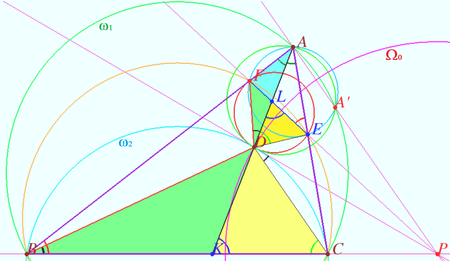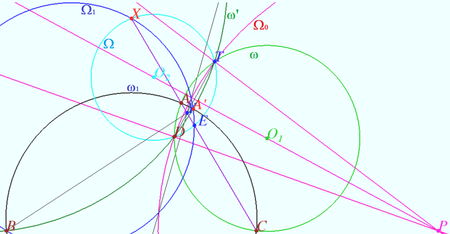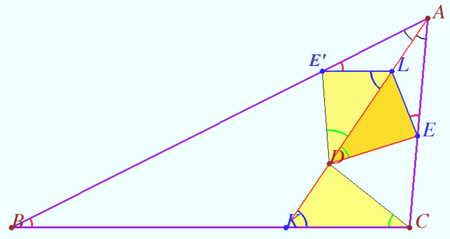Difference between revisions of "2021 IMO Problems/Problem 3"
(→Solution) |
Etmetalakret (talk | contribs) (→See also) |
||
| (11 intermediate revisions by 2 users not shown) | |||
| Line 3: | Line 3: | ||
==Solution== | ==Solution== | ||
| − | [[File:2021 IMO | + | [[File:2021 IMO 3j.png|450px|right]] |
| − | [[File:2021 IMO | + | [[File:2021 IMO 3i.png|450px|right]] |
| − | + | ||
| − | + | We prove that circles <math>ACD, EXD</math> and <math>\Omega_0</math> centered at <math>P</math> (the intersection point <math>BC</math> and <math>EF)</math> have a common chord. | |
Let <math>P</math> be the intersection point of the tangent to the circle <math>\omega_2 = BDC</math> at the point <math>D</math> and the line <math>BC, A'</math> is inverse to <math>A</math> with respect to the circle <math>\Omega_0</math> centered at <math>P</math> with radius <math>PD.</math> | Let <math>P</math> be the intersection point of the tangent to the circle <math>\omega_2 = BDC</math> at the point <math>D</math> and the line <math>BC, A'</math> is inverse to <math>A</math> with respect to the circle <math>\Omega_0</math> centered at <math>P</math> with radius <math>PD.</math> | ||
| − | Then the pairs of points <math>F</math> and <math>E, B</math> and <math>C</math> are inverse with respect to <math>\Omega_0</math>, so the points <math>F, E,</math> and <math>P</math> are collinear. Quadrilaterals containing the pairs of inverse points <math>B</math> and <math>C, E</math> and <math>F, A</math> and <math>A'</math> are inscribed, <math>FE</math> is antiparallel to <math>BC</math> with respect to angle <math>A</math> | + | Then the pairs of points <math>F</math> and <math>E, B</math> and <math>C</math> are inverse with respect to <math>\Omega_0</math>, so the points <math>F, E,</math> and <math>P</math> are collinear. Quadrilaterals containing the pairs of inverse points <math>B</math> and <math>C, E</math> and <math>F, A</math> and <math>A'</math> are inscribed, <math>FE</math> is antiparallel to <math>BC</math> with respect to angle <math>A</math> (see <math>\boldsymbol{Claim}</math>). |
Consider the circles <math>\omega = ACD</math> centered at <math>O_1, \omega' = A'BD,</math> | Consider the circles <math>\omega = ACD</math> centered at <math>O_1, \omega' = A'BD,</math> | ||
| Line 21: | Line 21: | ||
<math>\hspace{13mm}E</math> is the point of the circle <math>\Omega_1.</math> | <math>\hspace{13mm}E</math> is the point of the circle <math>\Omega_1.</math> | ||
| − | Let Y be the radical center of the circles <math>\omega, \omega',</math> | + | Let the point <math>Y</math> be the radical center of the circles <math>\omega, \omega', \omega_1.</math> It has the same power <math>\nu</math> with respect to these circles. The common chords of the pairs of circles <math>A'B, AC, DT,</math> where <math>T = \omega \cap \omega',</math> intersect at this point. |
| + | <math>Y</math> has power <math>\nu</math> with respect to <math>\Omega_1</math> since <math>A'B</math> is the radical axis of <math>\omega', \omega_1, \Omega_1.</math> | ||
| + | <math>Y</math> has power <math>\nu</math> with respect to <math>\Omega</math> since <math>XE</math> containing <math>Y</math> is the radical axis of <math>\Omega</math> and <math>\Omega_1.</math> | ||
| + | Hence <math>Y</math> has power <math>\nu</math> with respect to <math>\omega, \omega', \Omega.</math> | ||
| + | |||
| + | Let <math>T'</math> be the point of intersection <math>\omega \cap \Omega.</math> Since the circles <math>\omega</math> and <math>\omega'</math> are inverse with respect to <math>\Omega_0,</math> then <math>T</math> lies on <math>\Omega_0,</math> and <math>P</math> lies on the perpendicular bisector of <math>DT.</math> The power of a point <math>Y</math> with respect to the circles <math>\omega, \omega',</math> and <math>\Omega</math> are the same, <math>DY \cdot YT = DY \cdot YT' \implies</math> the points <math>T</math> and <math>T'</math> coincide. | ||
The centers of the circles <math>\omega</math> and <math>\Omega</math> (<math>O_1</math> and <math>O_2</math>) are located on the perpendicular bisector <math>DT'</math>, the point <math>P</math> is located on the perpendicular bisector <math>DT</math> and, therefore, the points <math>P, O_1,</math> and <math>O_2</math> lie on a line, that is, the lines <math>BC, EF,</math> and <math>O_1 O_2</math> are concurrent. | The centers of the circles <math>\omega</math> and <math>\Omega</math> (<math>O_1</math> and <math>O_2</math>) are located on the perpendicular bisector <math>DT'</math>, the point <math>P</math> is located on the perpendicular bisector <math>DT</math> and, therefore, the points <math>P, O_1,</math> and <math>O_2</math> lie on a line, that is, the lines <math>BC, EF,</math> and <math>O_1 O_2</math> are concurrent. | ||
| + | [[File:2021 IMO 3.png|450px|right]] | ||
| + | [[File:2021 IMO 3j.png|450px|right]] | ||
| + | <math>\boldsymbol{Claim}</math> | ||
| + | |||
| + | Let <math>AK</math> be bisector of the triangle <math>ABC</math>, point <math>D</math> lies on <math>AK.</math> The point <math>E</math> on the segment <math>AC</math> satisfies <math>\angle ADE= \angle BCD</math>. The point <math>F</math> on the segment <math>AB</math> satisfies <math>\angle ADF= \angle CBD.</math> Let <math>P</math> be the intersection point of the tangent to the circle <math>BDC</math> at the point <math>D</math> and the line <math>BC.</math> Let the circle <math>\Omega_0</math> be centered at <math>P</math> and has the radius <math>PD.</math> | ||
| − | <math>\ | + | Then the pairs of points <math>F</math> and <math>E, B</math> and <math>C</math> are inverse with respect to <math>\Omega_0</math> and <math>EF</math> and <math>BC</math> are antiparallel with respect to the sides of an angle <math>A.</math> |
| − | + | <math>\boldsymbol{Proof}</math> | |
| − | |||
| − | |||
| − | + | Let the point <math>E'</math> is symmetric to <math>E</math> with respect to bisector <math>AK, E'L || BC.</math> | |
| + | Symmetry of points <math>E</math> and <math>E'</math> implies <math>\angle AEL = \angle AE'L.</math> | ||
<cmath>\angle DCK = \angle E'DL, \angle DKC = \angle E'LD \implies</cmath> | <cmath>\angle DCK = \angle E'DL, \angle DKC = \angle E'LD \implies</cmath> | ||
<cmath> \triangle DCK \sim \triangle E'DL \implies \frac {E'L}{KD}= \frac {DL}{KC}.</cmath> | <cmath> \triangle DCK \sim \triangle E'DL \implies \frac {E'L}{KD}= \frac {DL}{KC}.</cmath> | ||
<cmath>\triangle ALE' \sim \triangle AKB \implies \frac {E'L}{BK}= \frac {AL}{AK}\implies</cmath> | <cmath>\triangle ALE' \sim \triangle AKB \implies \frac {E'L}{BK}= \frac {AL}{AK}\implies</cmath> | ||
<cmath> \frac {AL}{DL} = \frac {AK \cdot DK}{BK \cdot KC}.</cmath> | <cmath> \frac {AL}{DL} = \frac {AK \cdot DK}{BK \cdot KC}.</cmath> | ||
| − | < | + | Similarly, we prove that <math>FL</math> and <math>BC</math> are antiparallel with respect to angle <math>A,</math> and the points <math>L</math> in triangles <math>\triangle EDL</math> and <math>\triangle FDL</math> coincide. Hence, <math>FE</math> and <math>BC</math> are antiparallel and <math>BCEF</math> is cyclic. |
| + | Note that <math>\angle DFE = \angle DLE – \angle FDL = \angle AKC – \angle CBD</math> and | ||
| + | <math>\angle PDE = 180^o – \angle CDK – \angle CDP – \angle LDE = 180^o – (180^o – \angle AKC – \angle BCD) – \angle CBD – \angle BCD</math> | ||
| + | <math>\angle PDE = \angle AKC – \angle CBD = \angle DFE,</math> so <math>PD</math> is tangent to the circle <math>DEF.</math> | ||
| − | + | <math>PD^2 = PC \cdot PB = PE \cdot PF,</math> that is, the points <math>B</math> and <math>C, E</math> and <math>F</math> are inverse with respect to the circle <math>\Omega_0.</math> | |
| − | |||
| − | |||
| − | |||
| − | + | '''vladimir.shelomovskii@gmail.com, vvsss''' | |
| − | + | == Video solution == | |
| − | + | https://youtu.be/cI9p-Z4-Sc8 [Video contains solutions to all day 1 problems] | |
| − | |||
| − | + | == See also == | |
| + | {{IMO box|year=2021|num-b=2|num-a=4}} | ||
| − | + | [[Category:Olympiad Geometry Problems]] | |
| − | |||
Latest revision as of 09:29, 18 June 2023
Contents
Problem
Let ![]() be an interior point of the acute triangle
be an interior point of the acute triangle ![]() with
with ![]() so that
so that ![]() . The point
. The point ![]() on the segment
on the segment ![]() satisfies
satisfies ![]() , the point
, the point ![]() on the segment
on the segment ![]() satisfies
satisfies ![]() , and the point
, and the point ![]() on the line
on the line ![]() satisfies
satisfies ![]() . Let
. Let ![]() and
and ![]() be the circumcentres of the triangles
be the circumcentres of the triangles ![]() and
and ![]() respectively. Prove that the lines
respectively. Prove that the lines ![]() ,
, ![]() , and
, and ![]() are concurrent.
are concurrent.
Solution
We prove that circles ![]() and
and ![]() centered at
centered at ![]() (the intersection point
(the intersection point ![]() and
and ![]() have a common chord.
have a common chord.
Let ![]() be the intersection point of the tangent to the circle
be the intersection point of the tangent to the circle ![]() at the point
at the point ![]() and the line
and the line ![]() is inverse to
is inverse to ![]() with respect to the circle
with respect to the circle ![]() centered at
centered at ![]() with radius
with radius ![]() Then the pairs of points
Then the pairs of points ![]() and
and ![]() and
and ![]() are inverse with respect to
are inverse with respect to ![]() , so the points
, so the points ![]() and
and ![]() are collinear. Quadrilaterals containing the pairs of inverse points
are collinear. Quadrilaterals containing the pairs of inverse points ![]() and
and ![]() and
and ![]() and
and ![]() are inscribed,
are inscribed, ![]() is antiparallel to
is antiparallel to ![]() with respect to angle
with respect to angle ![]() (see
(see ![]() ).
).
Consider the circles ![]() centered at
centered at ![]()
![]() centered at
centered at ![]() and
and ![]()
Denote ![]() . Then
. Then ![]()
![]() is cyclic),
is cyclic),
![]() is cyclic,
is cyclic, ![]() is antiparallel),
is antiparallel),
![]()
![]() is the point of the circle
is the point of the circle ![]()
Let the point ![]() be the radical center of the circles
be the radical center of the circles ![]() It has the same power
It has the same power ![]() with respect to these circles. The common chords of the pairs of circles
with respect to these circles. The common chords of the pairs of circles ![]() where
where ![]() intersect at this point.
intersect at this point.
![]() has power
has power ![]() with respect to
with respect to ![]() since
since ![]() is the radical axis of
is the radical axis of ![]()
![]() has power
has power ![]() with respect to
with respect to ![]() since
since ![]() containing
containing ![]() is the radical axis of
is the radical axis of ![]() and
and ![]() Hence
Hence ![]() has power
has power ![]() with respect to
with respect to ![]()
Let ![]() be the point of intersection
be the point of intersection ![]() Since the circles
Since the circles ![]() and
and ![]() are inverse with respect to
are inverse with respect to ![]() then
then ![]() lies on
lies on ![]() and
and ![]() lies on the perpendicular bisector of
lies on the perpendicular bisector of ![]() The power of a point
The power of a point ![]() with respect to the circles
with respect to the circles ![]() and
and ![]() are the same,
are the same, ![]() the points
the points ![]() and
and ![]() coincide.
coincide.
The centers of the circles ![]() and
and ![]() (
(![]() and
and ![]() ) are located on the perpendicular bisector
) are located on the perpendicular bisector ![]() , the point
, the point ![]() is located on the perpendicular bisector
is located on the perpendicular bisector ![]() and, therefore, the points
and, therefore, the points ![]() and
and ![]() lie on a line, that is, the lines
lie on a line, that is, the lines ![]() and
and ![]() are concurrent.
are concurrent.
![]()
Let ![]() be bisector of the triangle
be bisector of the triangle ![]() , point
, point ![]() lies on
lies on ![]() The point
The point ![]() on the segment
on the segment ![]() satisfies
satisfies ![]() . The point
. The point ![]() on the segment
on the segment ![]() satisfies
satisfies ![]() Let
Let ![]() be the intersection point of the tangent to the circle
be the intersection point of the tangent to the circle ![]() at the point
at the point ![]() and the line
and the line ![]() Let the circle
Let the circle ![]() be centered at
be centered at ![]() and has the radius
and has the radius ![]()
Then the pairs of points ![]() and
and ![]() and
and ![]() are inverse with respect to
are inverse with respect to ![]() and
and ![]() and
and ![]() are antiparallel with respect to the sides of an angle
are antiparallel with respect to the sides of an angle ![]()
![]()
Let the point ![]() is symmetric to
is symmetric to ![]() with respect to bisector
with respect to bisector ![]() Symmetry of points
Symmetry of points ![]() and
and ![]() implies
implies ![]()
![]()
![]()
![]()
![]() Similarly, we prove that
Similarly, we prove that ![]() and
and ![]() are antiparallel with respect to angle
are antiparallel with respect to angle ![]() and the points
and the points ![]() in triangles
in triangles ![]() and
and ![]() coincide. Hence,
coincide. Hence, ![]() and
and ![]() are antiparallel and
are antiparallel and ![]() is cyclic.
Note that
is cyclic.
Note that ![]() and
and
![]()
![]() so
so ![]() is tangent to the circle
is tangent to the circle ![]()
![]() that is, the points
that is, the points ![]() and
and ![]() and
and ![]() are inverse with respect to the circle
are inverse with respect to the circle ![]()
vladimir.shelomovskii@gmail.com, vvsss
Video solution
https://youtu.be/cI9p-Z4-Sc8 [Video contains solutions to all day 1 problems]
See also
| 2021 IMO (Problems) • Resources | ||
| Preceded by Problem 2 |
1 • 2 • 3 • 4 • 5 • 6 | Followed by Problem 4 |
| All IMO Problems and Solutions | ||












